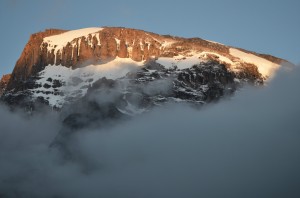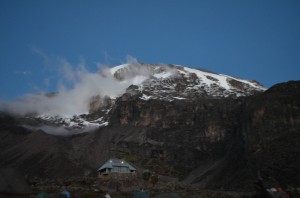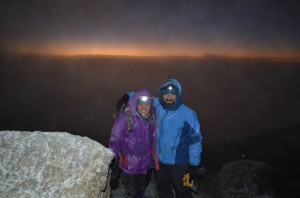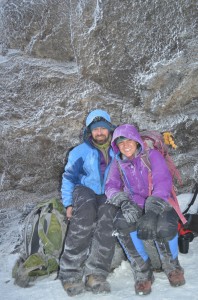I recently got the chance to summit Mount Kilimanjaro (19,341 feet) in Tanzania with my daughter, Jess. Over six days, as we worked our way up the mountain, I noticed how the snows of Kilimanjaro (the ones made famous by Ernest Hemingway) looked different as conditions changed. I also noticed how we had to adapt as the weather, the mountain and our situation changed.  Here’s a brief overview:
Here’s a brief overview:
Sunny Sky on Day 1 – The glaciers flashed bright white as we began our journey into the dense trees skirting Kilimanjaro. We ascended gradually to let our bodies acclimatize to the ever-thinner air. A purposeful strategy and the self-discipline not to rush were key in this early phase.
Rain on Day 2 – The rain forest earned its name as water poured from the sky and obscured the snowfields far above. Though we wore good gear, there was no way to avoid getting soaked, and so we had to simply accept the sogginess. Getting perturbed would not alter our physical or emotional comfort. Calm acceptance is the best way to embrace the inevitable.
 Starry Sky on Night 3 – After sunset in our third camp (12,800 feet), the burning stars kissed the glaciers above us with soft blue light. Though the evening started calmly, confusion soon reigned as one of our porters fell ill with what seemed to be malaria and altitude sickness. His low oxygen saturation level dictated an immediate evacuation downhill, so we chipped in gear and our Tanzanian guide and two other porters led him down into the darkness. Concern and uncertainty ruled the night. We had to let go of our plans, and see what the morning brought. In the mountains, and in life, when setbacks happen stay flexible. Let the situation unfold, then adapt your plans. (The evacuation succeeded and our porter, Idi, reached the hospital mid-day and received proper treatment for malaria, altitude sickness and dehydration).
Starry Sky on Night 3 – After sunset in our third camp (12,800 feet), the burning stars kissed the glaciers above us with soft blue light. Though the evening started calmly, confusion soon reigned as one of our porters fell ill with what seemed to be malaria and altitude sickness. His low oxygen saturation level dictated an immediate evacuation downhill, so we chipped in gear and our Tanzanian guide and two other porters led him down into the darkness. Concern and uncertainty ruled the night. We had to let go of our plans, and see what the morning brought. In the mountains, and in life, when setbacks happen stay flexible. Let the situation unfold, then adapt your plans. (The evacuation succeeded and our porter, Idi, reached the hospital mid-day and received proper treatment for malaria, altitude sickness and dehydration).
Summit Push on Night 5 – The shining moon set the glaciers aglow and illuminated the trail rising 4,000 feet to the top. After five days of testing ourselves, we  knew the ascent pace that we could sustain, and that would get us to the crater rim at sunrise. We needed consistency and control. Do not get lured into racing ahead when some stranger passes you. As you pass others, do not let uncertainty cloud your mind when you see them slumped on their packs, vomiting or staggering. Know what works for you and stick to it. Consistency and control are crucial.
knew the ascent pace that we could sustain, and that would get us to the crater rim at sunrise. We needed consistency and control. Do not get lured into racing ahead when some stranger passes you. As you pass others, do not let uncertainty cloud your mind when you see them slumped on their packs, vomiting or staggering. Know what works for you and stick to it. Consistency and control are crucial.
Summit Ridge at Dawn – For six hours, we held our steady pace until the rising African sun cut a swath through the enveloping clouds. The relentless wet winds smeared rime ice on the crater rim rocks and us. The last 45 minutes was an easy traverse as we slowly hiked clockwise around the crater rim to the true summit of Uhuru Peak (Freedom Peak, in Swahili) high above the African plains.
Because the mountain environment is ever changing, adaptation is necessary to survive, thrive and succeed. From cold, foggy nights high atop great volcanoes, we must remember the crucial lessons about adaptation, and bring them back down to green valley’s where we live. By applying the mountain’s lessons about adaptation to our daily lives, we’ll get the chance to rise above the clouds, and see the next sun-kissed challenges ahead.


That’s really cool you were able to climb with your daughter. I hope to do that someday as well.
You’re so right. Adaptation is a necessity in the hills.
Great job you two! What an experience!!
Great story Jim. What a wonderful adventure to complete with your daughter. Jess, nice job!
Thanks Terry. Yes, being able to do this with my daughter Jess made it very special. She was about the youngest person on Kili, and I was among the oldest, so it was great that our skills, abilities and interests all came together simultaneously for us to do this with one another.
Congratulation Jim, What an awesome experience. What route did you take? I’d love your permission to us the Kili photo (the mountain sticking up above the clouds). Can I get your permission to do so?